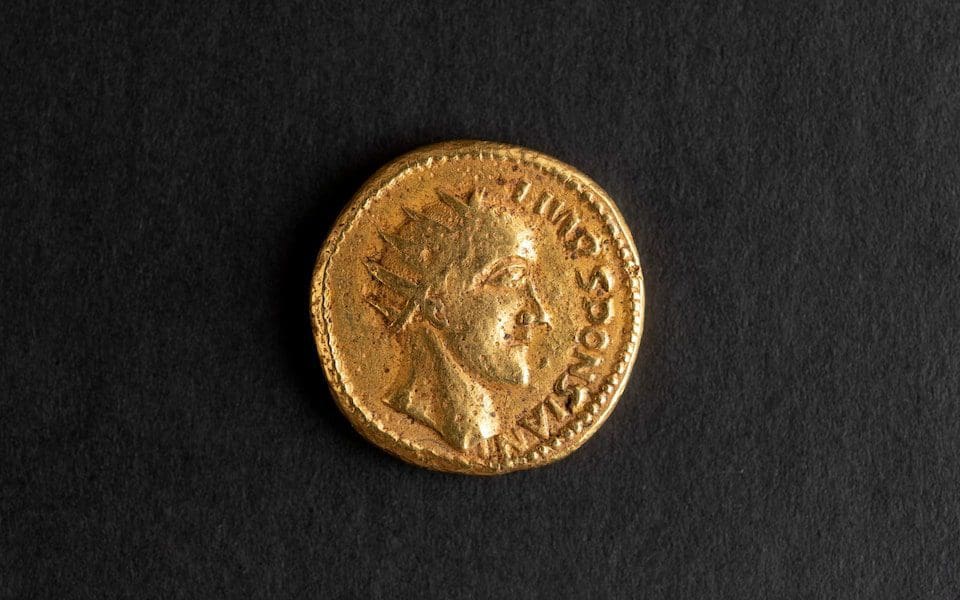

Following ‘the Science’ Will Lead You to a Hoard of Roman Gold Coins – or Maybe Not
You might think that a Roman coin and the ‘discovery’ of an unknown rebel Roman emperor of the 3rd century AD would have nothing to do with this website.
But actually it does, and I am as surprised as you might be. The reason is that it’s yet another example of how ‘the Science’ has been wheeled out to prove something, despite the screamingly obvious evidence to the contrary, and – naturally – the spurious claim has been lapped up and egged on by a credulous and headline grabbing press. This has lain behind so much misery in recent years I have begun to see it almost everywhere.
The news emerged in late November that a team of researchers had investigated an apparently Roman gold coin which was allegedly part of a hoard found in the early eighteenth century along with several other coins. They were all different, but they all shared the common denominator of not corresponding to any normal known Roman coins and being apparently made by an illiterate. One features the mysterious name IMP SPONSIANI, an otherwise unknown Roman emperor. This particular example has found its way to the Hunterian Museum in Glasgow.
The coins have always been dismissed as fakes, and with good reason. But the researchers (for reasons that are not entirely clear) decided to subject the Sponsianus coin to a variety of scientific techniques. This yielded the amazing discovery (see also here) that the coin had been in circulation in Roman times, on the evidence of scratching. From this the conclusion was drawn that it was genuine and thus constituted the discovery of a hitherto-unknown rebel Roman emperor in the late 270s AD. Bit of a stretch? I’ll say.
The BBC, as we all know, is the first organisation to fall down in abeyance before any scientific evidence. Naturally, the Science Correspondent Pallab Ghosh was straight round to jump on the story along with various other hacks who all presented the theory as fact. (Where have we seen that before?) Here’s a nice discussion of how the media got involved and dragged the researchers deeper into the quicksand.
You might not know much about Roman coins, but after half a century of collecting and researching them I do. Roman gold coins are very rare. They were very high value. They scarcely circulated and therefore normally only accumulated noticeable wear over very long periods of time (if at all). Wear itself is not evidence of authenticity. And it is of course possible to fake wear.
The legend on this particular coin is in the wrong place. And it’s missing at least half of what should have been included, including the crucial AVG for Augustus. Not much point in claiming to be a new emperor without adding that. Worse, the Sponsianus’ name is in the genitive, not the nominative. That never happens on Roman coins.
The primitive style of the coin, especially the eye, screams forger and one with a poor grasp of the necessary skills.
The reverse of the coin, far from featuring one of the standard propaganda attributes of a rebel emperor like ‘Strength’ or ‘Peace’, has been copied from a Republican coin of 135 BC. A totally irrelevant type recording a magistrate’s dole handout around 400 years earlier than the Sponsianus coin is claimed to be.
One of the other coins in the ‘hoard’, naming another but legitimate emperor, has an obverse apparently copied from the other side of the same Republican coin. That couldn’t happen unless they were being made by the same person. Several of the extant coins from this ‘hoard’ have totally illiterate and meaningless legends. That never happens on Roman coins unless they are fakes and even then it’s pretty rare to be that bad.
It gets worse.
Now, it’s true that there have been instances of hitherto-unknown rebel Roman emperors of the 3rd century AD turning up on a very small number of coins found in hoards. But those coins are always found in conventional hoards of well-known Roman emperors and their base-silver coins of the period. In other words, entirely in context and demonstrably reliable as belonging to the period. They conform in terms of propaganda types and style. They just weren’t around long enough to make any impact on the very thin historical evidence from the period. The Sponsianus coin comes from no such context.
I could go on, but I’ll save you that. If you want to, watch my video on the Sponsianus coin where you’ll find more detailed analysis and images. I’ll round that up by pointing that everyone I know in the numismatic and academic world, including some very well-known academic personalities, knows the story is nonsense but is very worried about coming out too openly to condemn what’s happened and the way it’s been peddled in the media.
For the moment I’m going to return to the main theme, which is the way the religion of scientific evidence means so often that almost any pronouncement deemed to be ‘scientific’ is pushed by its proponents and the media as fact, and a fact that overturns or blithely ignores any other contextual evidence rather than looking at all the evidence in the round. Legitimate conclusions are turned into teetering edifices that simply don’t bear up. Yet the usual outcome is people and institutions going too far and then becoming scared to lose face.
Not wholly surprisingly, and this is the icing on the cake for readers of this site, the chief proponent of the research team behind the Sponsianus discovery turns out to be none other than – yes, wait for it – a climate scientist.
You might at this moment be inclined to tell me: but what about Richard III? Didn’t scientific evidence prove the body was his? You’d be forgiven for believing that it had, but it didn’t. In this case the argument is reversed – the body is obviously Richard III’s, or at least you’d have to come up with some very good reasons for arguing otherwise.
The DNA testing applied to Richard III’s bones only suggested that they belonged to someone commensurate with descent down the female line from Cecily Neville, Richard’s mother. The Beaufort line of descent was broken, suggesting illegitimacy at some indeterminate point.
DNA does not name stiffs. And it didn’t name Richard III. In this case, the body’s location, its wounds, its appearance, approximate age at death, and tradition that stated he was buried in Greyfriars in Leicester, all meant that if it had been found in 1863 then it would still have been obvious that Richard III was the most likely candidate. The DNA evidence, such as it is, is no better than consistent with that. The only alternative is a John Doe who looked like Richard, was the same age, had the same battle damage, and was buried where Richard was said to have been buried, but wasn’t Richard.
Both cases, the Sponsianus coin and the Richard III body, are examples of triumphant use of scientific evidence, both of which ignored the existing evidence that was and is far more important. In the Sponsianus coin’s case all that can be said is that the coin was manufactured by someone who was illiterate, was unfamiliar with Roman coin formats, and that he did the work at an unspecified date before the early 1700s, generating a fantasy coin. In Richard III’s case, all the non-DNA evidence screamed out that Richard III was the most likely candidate.
Any serious, lateral, and three-dimensional research – and based on a bit more than only a ‘little knowledge’ – would have come to those conclusions. Instead, here we have two instances of ‘science’ being trotted out as the definitive evidence, obfuscating the stark-staringly obvious.
As an allegory for our times these two stories have a lot to tell us about our era. Both are in themselves quite harmless, but they symbolise something far more chilling which is affected all of us as the Science Cult overwhelms us. I’m not anti-science – not one bit of it – but I share Carl Sagan’s profound concern about the way some of us use science, convincing ourselves it is an infallible source of facts and so powerful that it can blind us not only to what ought to be obvious but also the empirical experiences and knowledge accumulated over lifetimes.
As Sagan said:
We’ve arranged a global civilisation in which most crucial elements profoundly depend on science and technology. We have also arranged things so that almost no one understands science and technology. This is a prescription for disaster. We might get away with it for a while, but sooner or later this combustible mixture of ignorance and power is going to blow up in our faces







